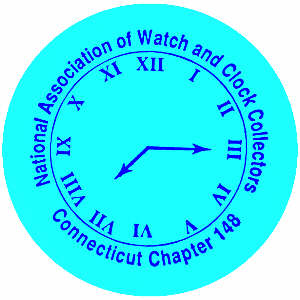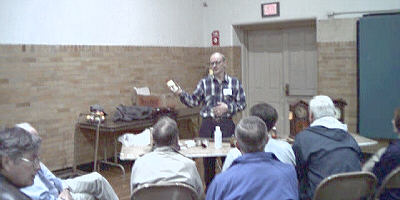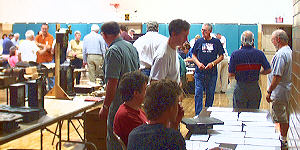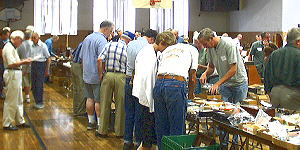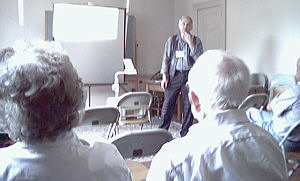Meetings PastMeeting Highlights - November 16, 2002
|
| Through Ron's talk, we visited obscure archives and viewed fragile documents undisturbed for 150 years. We discovered little-known technological developments, achievements and even tactics, for example, a fine 8-day, dual mainspring watch, a variety of models that seemed to have jewel settings but didn't, and a wonderfully elegant specimen sporting a gold balance. We encountered mysterious 19th century financeers and speculators. We travelled streets long since renamed, viewed buildings largely forgotten, inspected an original factory inventory, and experienced the turmoil of 19th century bankruptcy proceedings. |
|
Ron's draft document appears on the web at http://www.plads.com/m57/. He is scheduled to present his findings at the upcoming NAWCC Seminar in Boxborough, MA, on October 17-19, 2002.
We would like to thank Ron for sharing with us this delightful tale of the experiences, frustrations and discoveries in a lengthy horological research process. Special thanks is also due Ron for his unfailing efforts in hosting the Chapter's web site. Our web site may be viewed at http://www.pricelessads.com/nawcc148/
-- Mary Jane Dapkus
Timexpo Meeting Highlights - May 11, 2002
by Mary Jane Dapkus
On Saturday May 11, 2002, members, families and friends of Chapters 148 (CT), 2 (NY), 84 (Mid-Hudson) and 8 (New England) convened at "Timexpo 2002". Morning events included a sumptuous mart that filled the gymnasium of Kennedy High School in Waterbury, CT, and a series of technical workshops held in various classroom facilities throughout the building. Abundant refreshments were available in the building's commodious cafeteria.
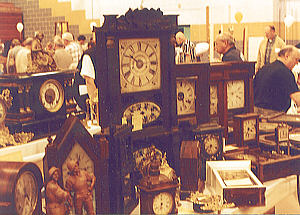
Among many interesting objects encountered at the mart were found a New Haven pull-wind gun metal "mirror" clock in its original box with papers; an Appleton, Tracy & Co. 18-size KW, M#1857, serial #359315 watch movement; several Elgin and Illinois Watch Company specimens; a National Photo Co. wax cylinder reproducer; a Seth Thomas range timer ca. 1930; an early 20th century "Admiral Fitzroy" barometer; and a late 19th or early 20th century Swiss-made mechanical music box.
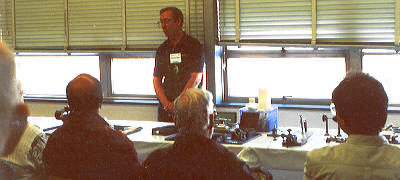
Daniel Nied, instructor and Director of the NAWCC School of Horology, attracted a standing-room-only audience to his lathe workshop, which encompassed bow-driven to advanced technologies. Attendees appreciated his practical approach, for example, to demystifying the controversy between polishes and stones. (For good results, it is necessary to keep polishes separate from each other by means of dedicated buffs). Successful use of a particular product or tool (as Daniel wryly quipped, you need them all), essentially depends on taking time to experiment with the particular product or tool, gaining an understanding of underlying principals and unique properties, and evaluating results before diving into a sensitive project.
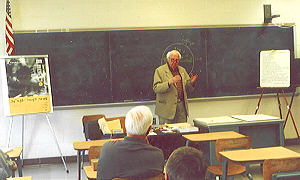 |
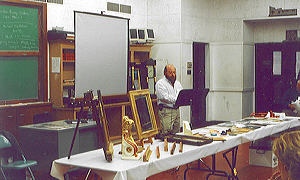 |
||
|
|
Timexpo participants proceeded to the nearby Timexpo Museum, situated in a restored brass mill building in Waterbury, for an afternoon of speakers, "backstage" tours, and the many attractions afforded by the Timexpo Museum itself, including its collections and interactive displays. Backstage tour participants were afforded the opportunity to browse the museum's impressive collection of Waterbury clocks contained in climate controlled vaults and storage spaces.
Russ Oeschle's presentation entitled "Asa Munger and His Fellow 8-day New England Clockmakers" began by crediting earlier primary research by F.W. McMillan and Kenneth Roberts, work that Russ has aptly built upon. Clockmakers Munger, Jared Arnold, Jr., Phillip Smith, Chauncey Marshall and Elmer Adams developed markets unsaturated by the peddlar trade and manufactured brass clocks in quantity until their respective businesses failed. Through Russ's efforts, we were afforded an opportunity to connect with the pre-1850 mid-New York state clockmaking industry to an unusual extent, including humorous glimpses into the personalities of some of the clockmakers and their associates.
The subject of Jim Storrow's presentation was the restoration of the Springfield, Massachusetts' Armory tower clock by a dedicated and resourceful team of Chapter 84 members. The tower clock's massive iron movement with nickel-plated gears and agate pallets, manufactured by R. Smith and Co. of New York and driven by a 400-lb. weight, was generally intact and in good condition. However, unique challenges were encountered attributable to missing transmission tubes, angular joints and a badly worn escape wheel pinion necessitating replacement. As part of this ambitious project, Mel Smith created a replacement shaft and gear, designing and building several tools in order to custom-machine the massive new gear. The replaced part was preserved as documentation of the clock's history.
We extend our sincere thanks to the many dedicated individuals whose efforts made "Timexpo 2002" both possible and memorable.
Chapter 148 remembers Ray Halsted, skilled watch repairer, fellow chapter member and Connecticut native who passed away recently. Ray's attraction to watches began early in life. His father was a dispatcher on the New York, New Haven and Hartford Railroad line. Ray recalled the importance of his father's watch, and the need to set it precisely at the correct time. He also acquired an interest in ship's chronometers while serving as a naval officer in World War II. After a career in insurance underwriting, Ray decided to accompany his wife, who enjoyed antique shows and flea markets. It was on one of their trips that Ray found a railroad grade pocket watch, and his hobby began in earnest.
Ray, already a mechanical "tinkerer", taught himself watch repair with the aid of books. He took great pride in keeping the watches in his collection properly timed and in good working order. An NAWCC member since 1984, Ray thoroughly enjoyed the friendships and knowledge he gained thereof. He will be missed.
- Mary Jane Dapkus, with special thanks to Elinor Halsted
* * *
Meeting Highlights - March 16, 2002
by Mary Jane Dapkus
The chapter's March meeting took place on Saturday the 19th. In addition to regular meeting features, NAWCC Council member (and fellow watch and clock collector) David Wood drove all the way from Pennsylvania to attend the meeting and to listen to members' thoughts relative to business aspects of the national organization. David also gave a brief presentation on the organization's status, challenges and goals. An NAWCC member since1998 with a strong background in actuarial science, David generously devotes his professional skills on a volunteer basis to evaluating the organization's financial aspect and future. We thank him for his ongoing efforts in these matters on our behalf.
We were saddened to learn of the death of another chapter member, Ray Halsted. As many of you know, Ray's dedication to and fondness for watch repair was legendary. The Chapter has made donations to both the American Clock and Watch Museum and the NAWCC Museum in Columbia, PA in Ray's honor.
Our technical presentation featured the amiable Tom Erb of the firm Electric Time, Inc., of Medfield, MA.
Their web site is http://www.electrictime.com/.
|
For anyone who might have thought the era of the public clock was essentially over, the information Tom provided was startling, to say the least. Founded in 1932, the Electric Time Company may have begun as an experimental laboratory for self-starting alternating current motors. This was because during the early decades of electrical power, master clocks were needed which could overcome problems with differences between line frequencies and keeping accurate time. Although the market for analog clocks nearly collapsed in the 1960's, the firm survived and began to grow. |
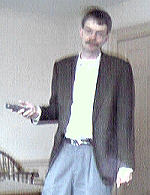 |
Electric Time presently makes approximately 1000 tower clocks, gallery clocks, scoreboards, and various types of custom clocks per year. As many of these are relatively large devices fitted into prominent and unusual public spaces, Tom's slides documenting technical aspects of various projects were uniquely thrilling and often humorous. An example dating from the 1940's at Dawson's in Kenmore Square has hands thirty feet long and a mechanism weighing 2000 lbs. Many examples feature both neon lights and transformers (the latter designed inhouse). Transformers located within the hands often act as counterweights.
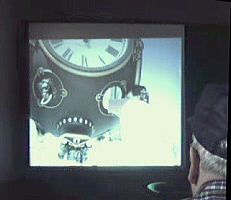 |
A relatively recent example made for a farmer's market in the City of Los Angeles, CA has a dial eight feet in diameter (all one piece) of half-inch thick tempered, laminated glass. On either side of the clock, a pair of massive, hand-sculpted fiberglass figures made to look like bronze, representing men working for the Works Progress Administration in the 1930's, wield equally massive hammers to strike a respective pair of outsized bells on the hour. Although the bells chime digitally, the clock has a dead stop mechanism so that the bells cannot be inadvertently broken by the generously overpowered mechanism. |
The dial of a clock installed by Tom's firm in Bermuda features fluid between double pieces of glass which accurately rises and falls corresponding to local tides! A computer program projecting the tide data for the next several decades is utilized and another drives the clock's hydraulics. Tom candidly provided humorous tales of technical challenges encountered during the project, replete with illustrations.
We particularly enjoyed Tom's description of the Tourneau Store "Time Machine" project, undoubtedly the most spectacular of all. (Tourneau is a famous watch shop located in New York City.) According to the company's brochure, the project consists of twenty-six 44-inch diameter "slave" clocks and one thirteen-foot diameter master clock, having day of the week, calendar and moon phase indicators. The twenty-six slave clocks each read a different time, accurate to the country represented by the clock. A computer program regulates the time for all the countries, including coordination of any changes. The system is highly complex digitally and mechanically. All of the clocks have stainless steel cases and laminated glass dials.
We would like to thank Tom again for his efforts in providing us a glimpse into this innovative and dynamic enterprise.
- Mary Jane Dapkus
* * *
Meeting Highlights - January 19, 2002
by Mary Jane Dapkus
The chapter's well-attended January meeting, our first in 2002, took place on Saturday, January 19. The meeting featured mart, silent auction, refreshments, and works-in-progress. The January meeting did not include a speaker.
As always, the mart provided a stimulating backdrop. Noteworthy objects included many old and new clock and watchmaking tools and parts. Items encountered included: a pallet jewel setting tool with dial indicator; a bow operated pivot polisher; a jeweler's lathe; a set of Swiss watch wheel cutters; and an assortment of pocket watch hands and movements. The mart continues to be an excellent source for reference books, both new and out-of-print.
We were saddened to learn that two chapter members, Gilbert Anyon and Bertrand St. Onge, recently passed away. Bertrand St. Onge was a native of St. Methode, Quebec, who came to the United States upon being recruited to work for a forestry service company. The job brought him to Connecticut in 1951, and he became a U.S. citizen in 1959.
Bertrand became interested in clock repair when presented with a clock, originally purchased by his father, which was not running. His interest led him to pursue several clock repair courses. He spent many pleasant hours repairing clocks with friends and was a familiar face at Chapter 84 and 148 meetings.
We would welcome hearing from members having information regarding Gilbert Anyon and his interest in clocks. We extend our condolences to Gilbert's and Bertrand's families and friends, and to other chapter members whom we learned have recently lost loved ones. The Chapter made donations to both the American Clock and Watch Museum and the NAWCC Museum in Columbia, PA in their honor.
- Mary Jane Dapkus, with special thanks to Aubrey Kinney for his assistance.
